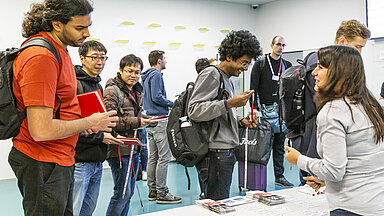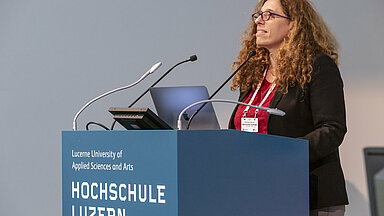October 01, 2019 - by Sarah Waldrip
With around 110 participants, this year’s CSCS User Lab Day saw an increase in attendees compared to last year’s event. Attended by researchers from a diverse range of scientific backgrounds as well as hardware technicians and software developers, the event provided ample time for conversation with CSCS staff about the current best practices and resources, as well as the future services already on the horizon. CSCS support staff, led by Head of User Engagement & Support Maria Grazia Giuffreda, hosted the day-long event at the Hochschule Luzern. The school, located on the lakefront just minutes away from the city center, offered an auditorium for the scientific keynote and other presentations from CSCS staff, as well as smaller rooms for the six parallel sessions devoted to more specific needs and interests of attendees.
Keynote: HPC Propels Race to Mars
Domenico Giardini has been a Professor of Seismology and Geodynamics at ETH Zurich for more than 20 years. He has a robust résumé filled with international projects and titles, but most relevant to his keynote at User Lab Day is that he is Co-PI of the 2015 ESA Pathfinder mission to test technologies for the detection of gravitational waves in space, as well as the 2016 NASA InSight (Interior Exploration using Seismic Investigations, Geodesy and Heat Transport) mission to install a seismometer on Mars.
In his keynote presentation “Next stop Mars”, Giardini explained that these InSight seismometers planted on Mars provide scientists with the data needed to model the interior of the Red Planet. Seismic wave readings are made by either “marsquakes” or meteoric impacts, which scientists can use to computationally generate an image of the geological structure of the planet and hopefully learn more about its formation. Institutions, including ETH Zurich, contributed to the mission, which successfully resulted in data on the location and characteristic of seismic waves and the size and state of the planetary core.
The origin and evolution of Mars is finally coming into focus for researchers. However, Giardini concluded his presentation by asking the audience to consider: Why should we go to such effort to go to Mars? He proposed five reasons that go beyond scientific curiosity and refer to the deeper reasons that compel us to send people to Mars eventually: because we are emotional and want to experience Mars in a way robots cannot do for us; because it represents an alluring challenge and mystery that simply cannot be found on Earth anymore; because we might need an alternative to Earth for the survival of our species; because we want to know where life originates; and because we are both fearful and hopeful about the future and the universe.
Parallel Sessions: Researchers Learn Directly from CSCS Staff
Six parallel sessions, three before lunch and three after, gave attendees a variety of options for sharpening their knowledge on the various services provided by CSCS. Attendees were able to attend sessions of their choice, ranging from an introduction to CSCS infrastructure and cloud services to advanced users’ guidelines for “Massively Parallel Many-Core and GPU-Accelerated HPC Simulations”.
“I try to come to these user events, because it’s really the most direct way to get updated and make contact with the people of CSCS,” says Carlo Antonio Pignedoli, a computational materials scientist working for Empa, the Swiss Federal Laboratories for Materials Science and Technology, who has conducted research at the Centre for about twelve years. After attending the afternoon workshop for advanced users, he reflected on the importance of these events for keeping up with evolving technology and software possibilities. “High-performance computers are fundamental to my job,” he says. Even though Pignedoli prefers to be focused on his materials research, he came to User Lab Day to take the opportunity to learn more effective ways to work with CSCS’s resources, both technical and human.
“The infrastructure for users has become much more complex,” he says. “Especially for my research field, the fact that they moved to an architecture that heavily relies on GPUs brings some additional complexity,” Pignedoli explains. “But luckily, there was a strong collaboration between the software developers and CSCS, to enhance the code I particularly use, to efficiently take advantage of the accelerated architecture. So now, at least in my research field, we have software that is aligned with the available technology, thanks to the tight collaboration with CSCS.”
Another attendee, Jonathan R. Buzan, is a new user at CSCS, but he is no stranger to the effort of adapting codes to GPU-based supercomputers. He’s a Post-Doctoral researcher in climate science at the University of Bern, specifically studying nuclear waste storage. Buzan’s current research project is his first conducted at CSCS, so this event was his first face-to-face interaction with the CSCS staff. After he attended the morning workshop on CSCS infrastructure to get “a glimpse into why things are done the way that they are” and how to adapt his work to the new computing environment and architecture he discussed the challenges that he and his colleagues are facing with new technologies.
“There have been some attempts to try and move our software stack to GPU units, but not all the current codes that have been developed over the past thirty years are adaptable. Not all scientific disciplines can take advantage of accelerator processors,” he says. He and other climate researchers are using high-performance computing (HPC) to work with a gargantuan amount of data compared to other HPC users, so making use of cloud infrastructure might be a non-trivial effort, if possible. “Global circulation models require thousands of cores, hundreds of thousands of core hours, and they produce millions of files and terabyte- to petabyte-scale amounts of data. For example, the project that I am on is expected to produce something around five petabytes of data, and that’s just one project,” he explains. “You cannot do this without HPC resources.”
“Up-to-date solutions with a view on what’s coming next"
The User Lab Day was concluded with a lively presentation by Nicholas P. Cardo on behalf of HPC Operations team. Cardo gave away small amounts of additional compute hours on “Piz Daint” as rewards for audience participation in several quizzes about CSCS and information available in the CSCS Annual Reports, and he also brought along some hardware components for attendees to see up-close and learn about how they work. A short update on the User Lab in numbers and concluding remarks from Maria Grazia Giuffreda signed off the official program.
After presentations had concluded, attendees were invited to an afternoon apéro with refreshments to mingle and continue discussions on the day’s topics. Participants were encouraged to follow up with staff members with any lingering questions or ideas. “At CSCS,” says Pignedoli, “they created a very stable infrastructure. They always manage to bring you up-to-date solutions with a view on what’s coming next. The job they do is to make it easy to run calculations on competitive supercomputers, easy to use infrastructure, easy to understand how to apply for CSCS resources; and whenever there is a problem, they are prompt in trying to help you fix it or put you in contact with someone who could.”














